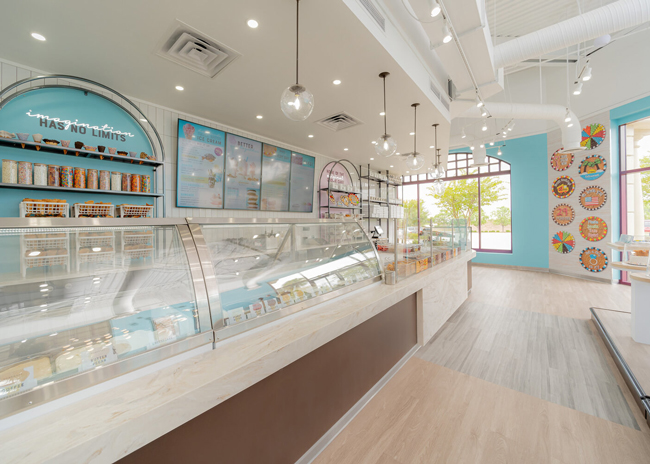Careful planning and strong communication are two keys to ensuring a successful restaurant construction process. By planning well and making sure everyone — from architect to engineers to operators — is on the same page, owners can help ensure a smooth construction process and a successful start to their operation.
Know What You’re Getting
 Joe Crowley, Senior Project Manager, Trinity Building + Construction ManagementSelecting the right architect and engineer for your project is important. Just as important: selecting the right level of service from these team members.
Joe Crowley, Senior Project Manager, Trinity Building + Construction ManagementSelecting the right architect and engineer for your project is important. Just as important: selecting the right level of service from these team members.
Every architect and engineer offers different services and packages that cover drawings, sketches, site visits and more. Most of the time, the different services don’t line up from company to company, making apples-to-apples comparisons difficult.
It’s worth taking the time, though, to really know what you’re getting from the companies you hire. Dive into what a drawing entails or what a sketch covers. Ask about how everything will be coordinated with all the project partners. Once you have all this info, take a hard look at what services you really need. Bounce different ideas and services off general contractors or owner’s reps that have experience in these fields. Even if you’re not working with them this time, most will talk to you just to build a relationship.
Related: With all the different levels of service you can purchase from your designers, it’s tempting to go cheap. Be careful of going too cheap, though. I’ve seen owners shell out tens of thousands of dollars to correct mistakes that could have been avoided by paying for an extra site visit or additional sketches.
Coordinate Drawings
A restaurant is built on design plans. There’s not just the architectural design but also drawings for mechanical (such as the HVAC system), electrical, plumbing and kitchen equipment.
It makes perfect sense that all of these would be coordinated, but much of the time, they’re just not. A restaurant could have as many as four different groups developing their own plans. If they don’t all match up, you could find yourself paying big money to fix a mistake discovered during construction.
I’d recommend the owner assign one member of the team — probably the architect — to the job of coordinating drawings. Everyone involved in making these drawings should meet regularly (in person or on the phone) and go over their work piece by piece. You may have to pay a little more for everyone’s time, but these meetings could easily save you tens of thousands of dollars in unexpected design changes.
Order On Time
In many cases, operators want to order their restaurant’s furniture, fixtures or equipment themselves. This isn’t necessarily a mistake, but if not done properly, it can lead to scheduling trouble.
A restaurant has to be built in a particular order, so one delay can have a domino effect on your schedule. Waiting for the delivery of a particular tile will push back the furniture installation, along with everything else that has to be done after the furniture is installed.
A lot of this comes down to lead time. When you’re just considering placing an order, the manufacturer will give you a lead time for that product. While most manufacturers try to hit the dates they give you, you can’t count on them as absolute. Once you actually place the order, then you’ll get the real lead time. It could be several days or even weeks later than what you’d been expecting.
Other times, restaurant operators assume that if a product is available today, it will be available tomorrow. That isn’t always the case. I’ve had clients confirm with the manufacturer that a particular stone was in stock, then wait weeks to actually place their order. By that time, the stone wasn’t available. The client then had to choose between buying a product that they didn’t actually want or delaying construction.
Unless there’s some in-house expertise, I’d recommend owners avoid these problems by handing ordering off to another party. That can be the general contractor, who will take on this work for a small fee, or an owner’s representative. These companies have experience with the entire construction process and can help operators get the product they want when they need it.
Keep Your Operations Team Involved
Remember that you’re not just building a restaurant for customers. You’re also building it for the people who work there. You want a facility that makes it easy for your employees to do their jobs. To get an employee-friendly design, many owners seek feedback from their operations team during the design process and at the beginning of construction.
While that’s good, it’s only a start. Owners should also have their operations team visit a site in in the middle of construction. This will give them the chance to understand how the facility will work in the real world, not just on paper. Once operations teams are in an actual building and see how and where people will actually do their jobs, they’ll more than likely find problems with the design or at least ways to improve the flow of work.
While fixing a problem during construction will increase your build costs, you could easily pay double to solve the same problem once construction is complete. At that point, the problem may just be too expensive to fix, leaving you with a facility that doesn’t run smoothly. This can slow down service, costing you customers and money. It could even drive away employees who get frustrated with working in a poorly designed space.
Train Off-Site
After a facility is completed, many new restaurants will bring their employees in for a week or two of training. During that time, money is going out for utilities and salary but not coming in. Factor in the possibility that the building inspector could demand changes before issuing a certificate of occupancy, and a restaurant could be ready to go for a full month but not generating any money.
While you can’t control the building inspector, you can control training. I’d recommend owners try to train their employees off-site, just before construction is scheduled to be completed. That way, you can have your restaurant earning money as soon as the building is ready to go.
There are several ways you can do this. If you’re part of a chain, training can take place at another restaurant, maybe during off hours. If that’s not possible, look into renting a space for a month and setting up a temporary kitchen. There are plenty of spaces in malls, strip malls, office parks and even warehouses that have the utility hookups you’ll need to set up a temporary kitchen.
Getting the equipment for one of these kitchens could be a challenge. Chains could consider investing in a spare kitchen package that could be moved from site to site as needed. Smaller operations could talk to their manufacturers’ reps about training possibilities. While it may be hard to arrange, if you can pull it off, your restaurant will start paying for itself as soon as possible.
Set a Deadline for Design Changes
If there’s one thing I’ve learned in my many years in construction, it’s that no set of drawings is perfect. There will always — and I mean always — be changes.
That being said, owners need to set a firm deadline for changes to the design and make sure the team sticks to it. Tell your architect and engineers that all drawings must be final by the deadline — no matter what.
Not having this deadline can lead to all sorts of problems. In construction, a single change can impact many other areas. The later these changes are made, the more might have to be done (or undone) to implement them. This can add to the project’s final cost and push back the construction schedule. In the end, it’s easier to just avoid these problems by being clear to your team about what is expected of them and when it’s expected.
These aren’t the only things to look out for in order to ensure a successful project. You’ve got to get good, thorough feedback at site visits; stay in touch with your GC and more. But by following this advice, operators can set themselves up for a smooth construction period with as few surprises as possible followed by a timely and prosperous opening. +



